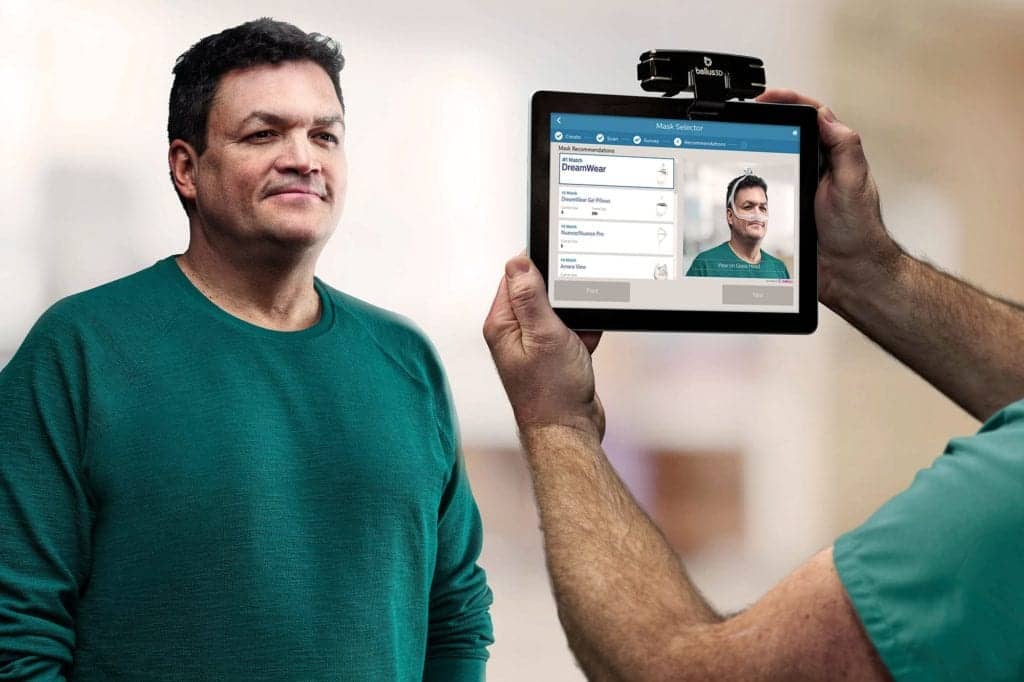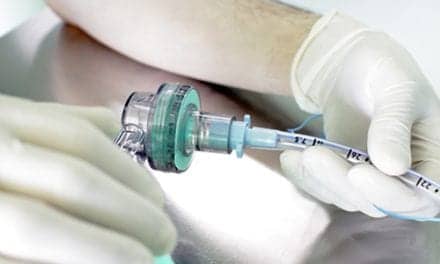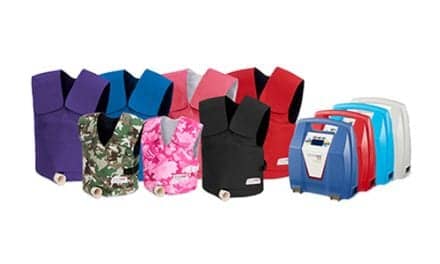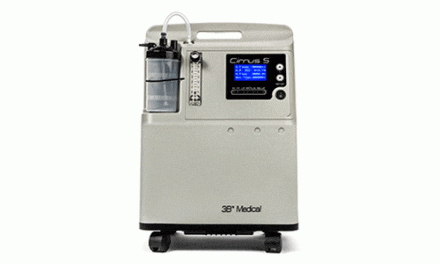The new facial scanning system analyzes each patient’s anatomy to recommend a more precise CPAP mask size.
By Lisa Spear
Obstructive sleep apnea (OSA) patients are all too familiar with the trials and tribulations of continuous positive airway pressure (CPAP) mask selection. In search of a restful night’s sleep, these patients often turn to CPAP, only to realize that their new mask doesn’t quite fit.
As a result of an ill-fitting CPAP mask, the pressurized air that is supposed to keep the patient’s airways open and their blood oxygenated throughout the night, ends up leaking out the sides of the mask. Clinicians often report that frustrated patients return again and again for refits and many of them give up all together before finding the right fit.
The Philips Respironics Mask Selector 3D is a new tool that aims to change the status quo of CPAP interface selection with a data-driven approach. The system uses facial scanning technology to take the guesswork and human bias out of mask selection. To capture the scan, the provider holds a camera attached to a tablet up in front of the patient’s face, and the device is moved from one side of the face to the other.
The 3D camera and proprietary algorithm then capture more than 100,000 data points. Then the system generates a personalized recommendation, based on facial geometry and a patient survey. One of the goals is to get the right fit, the first time, and clinicians are reporting that the tool is living up to that promise.
“I think it is helping with adherence. I think we are getting it right, more often, the first time,” said Kentucky-based sleep specialist Michael Zachek, MD, the medical director for The Physicians’ Center for Sleep Disorders, a division of the Graves-Gilbert Clinic in Bowling Green, Kentucky.
“It doesn’t take long and it makes the patient happy,” said Zachek, who is also a site visitor for the American Academy of Sleep Medicine, the professional society for the medical subspecialty of sleep medicine. “A happy patient is a patient that is more likely to benefit from CPAP.”
Zachek, who has been using the Philips Respironics Mask Selector 3D in his practice for approximately six months, said it didn’t take long for him and his team to fall in love with the tool. Fewer patients, he said, are contacting him with complaints about their CPAP interfaces.
“Patients are coming back and saying, ‘Yeah, the one that you suggested is the one that I got and I like it,” Zachek said. “It also gives patients that confidence that we are doing everything we can to get the right mask in their hands as quickly as possible.”
A Philips-sponsored clinical trial found that 9 out of ten patients successfully fit with one mask at the initial set-up and there was a more than 50% reduction in mask refits during the first 90 days of CPAP therapy. This compares to the typical rate of 1 out of 3 patients who need to be refitted for a mask after a sleep test, according to research published in the journal Sleep.1
According to information provided by the manufacturer, 275 medical device providers are currently using the Philips Respironics Mask Selector 3D and the numbers have only grown in recent months.
“We have seen a tremendous increase in the number of sites signing up and scans being performed,” said Mark D’Angelo, business category leader of sleep at Respironics Philips. He explained that the coronavirus pandemic has expedited providers’ interest in technology that will allow them to measure a patient’s face without physical contact.

Durable medical equipment (DME) providers and sleep technologists use the 3D version in-house to capture the anatomy of a patient’s face. Additionally, a Philips Respironics Mask Selector 2D system, launched during the pandemic, is a similar system that enables patients to take a photo of their own face at home to get fitted for a CPAP mask, without ever having to come into an office, and without having to come in physical contact with a healthcare provider.
The 2D solution uses the same proprietary algorithm as the advanced 3D solution, helping to remove the element of patient error from the equation while supporting those who cannot get to a sleep lab for sizing.
While this system is designed for use with a mobile device, a user can also use their computer camera to capture the photos. Any tablet, desktop or laptop device enabled with Windows 10 and meeting a list of specifications can be used with the Philips Respironics Mask Selector.
“This alternative self-scan solution simplifies the remote sizing process, sharing standard mask recommendations in moments and making them available to the DME for review, validation and fulfillment,” said D’Angelo. “…Deeply rooted in data and science, Philips Mask Selector promises to transform the way DMEs and sleep labs provide care and CPAP patients experience care.”
For most sleep technologists and DME providers, mask selection is more of art than a science. Typically, face measurements are taken manually. In some cases, analog sizing guides used during this process can be inaccurate and there is no standardization in the CPAP mask fitting process. Mask Selector 3D is a push to change that, D’Angelo explained.
“By standardizing the mask selection process with personalized care, both patients and providers have confidence that the selected mask is the best option for their individualized needs, leading the way to improved business efficiencies and successful therapy adherence,” he said.
Typically, patients may find that there is not enough diversity in the size and shape of masks to meet their needs. But the Philips Respironics Mask Selector 3D system goes far beyond the typical “small,” “medium,” and “large” sizes to recommend masks for a more diverse range of facial anatomy, said Utah-based sleep technologist and sleep lab manager Jared Lamb, RPSGT.
Philips DreamWear under-the-nose cushions are available in 11 sizes to fit people with a variety of nostril shapes.
“The precise-fit cushions have made a big difference in our patients’ satisfaction,” said Lamb, manager at the sleep lab at Advanced Pulmonary Sleep Disorders & Internal Medicine in St. George.
“We have had patients who have been on the DreamWear for a long time and we try them on the precise-fit cushions and they think it is the greatest thing ever,” said Lamb. “They say it fits them so much better. It helps especially for people with more narrow noses. The ‘small’ sizes tend to still be a bit wide, but with the precise-fit under-the-nose cushions, that are a lot more narrow, they don’t get near as many leaks.”
According to information provided by Philips Respironics, the precise-fit cushions are designed based on a database of thousands of facial scans, including from many ethnicities, to fit each patient’s individual features using proprietary algorithms. As of right now, these cushions can only be correctly selected and sized with the Philips Respironics Mask Selector 3D tool, according to D’Angelo.
One of the only limitations, Lamb found, is that tool only recommends Philips masks, which might be a deterrent for some sleep labs. Even before using the Mask Selector 3D, he said, his lab always leaned toward using Philips masks primarily and he isn’t bothered by it.
Currently, the Mask Selector recommends nine masks in Philips current sleep apnea portfolio, including DreamWear, DreamWisp, Amara View, Wisp, Nuance and Pico masks. And Philips semi-custom cushions are available in an expanded range of sizes based on variations in facial topography for current DreamWear nasal users.
Overall, Lamb said, the system is easy to use and has given his patients more confidence in the mask selection process. The tool also cuts down on waste.
“A lot of times there a multiple masks opened to try to fit a patient properly, and ultimately, we want to try to reduce that waste, if possible,” senior global product manager at Philips, Melissa Ross, said during a recent presentation at the virtual 2020 SLEEP show in August, a trade event organized by the Associated Professional Sleep Societies (APSS).
After the mask recommendation is selected, the Mask Selector then generates a visualization screen, which superimposes an image of the mask recommendation on the patient’s face to show them what they will look like with the mask on before they are handed an actual interface to try on.
“This really improves patient confidence,” said Lamb. “It’s not just me looking at them and saying, ‘Well, you are a small or a medium.’ It gives them something to look at, and they can look at the different masks and see how they will fit, before I go pull a whole bunch of masks out of the closet. And it shows them how it works.”
Additionally, DME and clinicians can sync this fitting tool with other Philips services such as the patient management solution Care Orchestrator, a cloud-based, home health population management solution for overseeing sleep apnea care.
This enables providers to save more time and resources by reducing overhead and office visits, while ensuring personalized patient coaching to promote adherence.
The system also can be paired with the Philips Patient Adherence Management Service (PAMS), a personalized program that provides sleep apnea education from a team of sleep coaches during the patient’s first 90 days of using their new therapy.
When using both the Philips Respironics Mask Selector 2D and 3D, after the scan is captured, the patient answers a brief survey about their sleep habits and preferences. These questions may harvest information about sleeping posture, snoring, claustrophobia, nasal congestion, and mouth breathing. The whole mask selection process typically takes only a few minutes.
The Kentucky-based sleep specialist Zachek said he is finding it helpful for patients who had failed CPAP therapy in the past due to improper mask fit.If a patient comes back to his clinic, and they are struggling to consistently use their CPAP therapy, he will ask them if they have been scanned yet with the Philips Respironics Mask Selector 3D tool. “That way they know, at least, that they got the right size,” he said.
After the recommendations are generated, he works with the patients to review types of interface, including under the nose masks or nasal pillows.
While working as a site visitor for the American Academy of Sleep Medicine, Zachek discovered the Philips Respironics Mask Selector 3D tool at a sleep practice in Tennessee, where clinicians were beta testing the tool, and knew he needed to have it in his office.
Philips allowed him to test it out in his sleep center for a few weeks.
“We fell in love with it,” he recalled. It seemed like a no-brainer to purchase the Philips Respironics Mask Selector 3D for the sleep center. “We’ll use it regularly.”
Since then, he has tried to convince a number of the DME providers in his local area to also use the Philips Respironics Mask Selector 3D, and is waiting to hear how they like it. “It really has been a very flexible tool,” he said.
For sleep lab managers or DME providers who are interested in trying out the Mask Selector technology, equipment is available for direct purchase or monthly rental, bundled or at individual equipment levels with an optional 60-day evaluation period, according information provided by the manufacturer.
RT
Lisa Spear is associate editor of RT. For more information contact [email protected].
References
- Mastromatto N, Killough K, Keenan BT, et al. The effects of changing the first CPAP mask on compliance. Sleep 41(1):A399-A400. DOI: 10.1093/sleep/ zsy061.1074.










